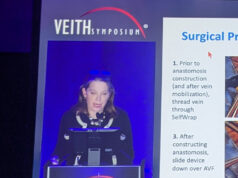 A survey recently conducted by Medtronic and the US National Kidney Foundation (NKF) found that patients undergoing haemodialysis lack awareness about minimally invasive treatment options for creation of an arteriovenous fistula (AVF). The survey of more than 400 dialysis patients and care partners also showed patients have a high level of trust for their physicians, presenting an opportunity for greater patient-physician dialogue around treatment options for candidate patients.
A survey recently conducted by Medtronic and the US National Kidney Foundation (NKF) found that patients undergoing haemodialysis lack awareness about minimally invasive treatment options for creation of an arteriovenous fistula (AVF). The survey of more than 400 dialysis patients and care partners also showed patients have a high level of trust for their physicians, presenting an opportunity for greater patient-physician dialogue around treatment options for candidate patients.
“Blood access is one of the greatest challenges faced by people treated with haemodialysis both at home or in a clinic,” said Joseph Vassalotti, chief medical officer for the NKF in a press release. “Haemodialysis access complications can include infection and mechanical complications that are related to frequent use, typically three times weekly. A mature AVF as a haemodialysis access generally has lower complication rates than haemodialysis catheters.”
Gaps in current standard of care
The long-standing standard of care for the last 50 years to create an AVF as a dialysis access point is an open surgery, the press release states, which requires an incision in the arm or wrist. Nearly all patients surveyed (about 95%) reported having had surgery to create their fistula. Less than 4% of patients reported they received a newer minimally invasive AVF creation procedure. Minimally invasive AVF procedures have been available for approximately five years.
The survey revealed patients’ top concerns when speaking to their physician about a haemodialysis access procedure, including long-term maintenance and upkeep (45%), effectiveness of the fistula (42%), and fear of complications (30%).
Addressing patient preferences with minimally invasive solutions
Minimally invasive AVF creation procedures often do not require open surgery. With these procedures, physicians will use a catheter such as the Ellipsys vascular access system (Medtronic), which received FDA clearance in 2018, that uses heat to fuse the artery and vein together in a procedure that usually takes 30 minutes or less.
“Minimally invasive AVF creations are an emerging technology, so there is great opportunity to help kidney patients who will require dialysis to learn more and discuss with their physician if they are a candidate for this type of fistula creation,” said Terry Litchfield, a kidney patient advocacy consultant. “Patient feedback on using minimally invasive technology to create a fistula has been positive. For example, haemodialysis patients have said that they appreciate that a fistula can be created through an outpatient procedure rather than an open surgery.”
Clinical studies have shown, says the press release, that patients who have a fistula access created using a minimally invasive technique tend to have better outcomes and find the experience easier than patients who’ve undergone a more invasive surgery.
Survey results indicated that patient concerns regarding dialysis access via fistula include ability to return to an active lifestyle (32%), appearance of the fistula on their body (26%), and recovery time and side effects (14%). Minimally invasive AVF creation procedures “directly address these patient concerns”, the press release adds.
“Patients having a voice leads to patients having a choice,” Litchfield said. “There needs to be greater awareness among patients that minimally invasive fistula creations procedures are an option for many people. When patients are informed about all their eligible options, the treatment plan becomes their choice.”
The patients with kidney disease/care partners surveyed also reported a high level of trust for physician guidance in treatment plans, showing an opportunity for more patient-physician dialogue around treatment options. Within the poll, 79% of patients/care partners reported they had talked to a nephrologist for trusted treatment information and 76% ranked physician recommendation as the top factor impacting their treatment selection.
“Shared decision making between the patient and nephrology care team about the options for kidney failure replacement therapy is very important,” Vassalotti said. “Focusing on shared decisions can help patients better understand their kidney failure replacement options, including kidney transplantation, haemodialysis at home or in a centre, or peritoneal dialysis. Our goal is that kidney patients can have multiple interactions with their care team, supported by educational materials from NKF and others that leave them feeling well informed about the full scope of treatment options.”
The survey was conducted online within the USA by the NKF and Medtronic. National Kidney Foundation members numbering 420 who self-reported as being a person currently or previously on dialysis or care partner for a person currently or previously on dialysis responded to an email survey.
The survey ran from 20–29 March, 2023. The respondents were 75% dialysis patients and 25% family, friend or other relation to a dialysis patient. Respondents were 51% male, 47% female, and 1% non-binary; 75% were over the age of 50 and 23% under 50 years old. Dialysis start times were reported as less than one year by 12%, 1–2 years by 29%, 3–5 years by 25%, and more than 5 years by 33% of respondents. Having haemodialysis access by an AVF was reported by 62% (259) of patients and/or care partners surveyed.












